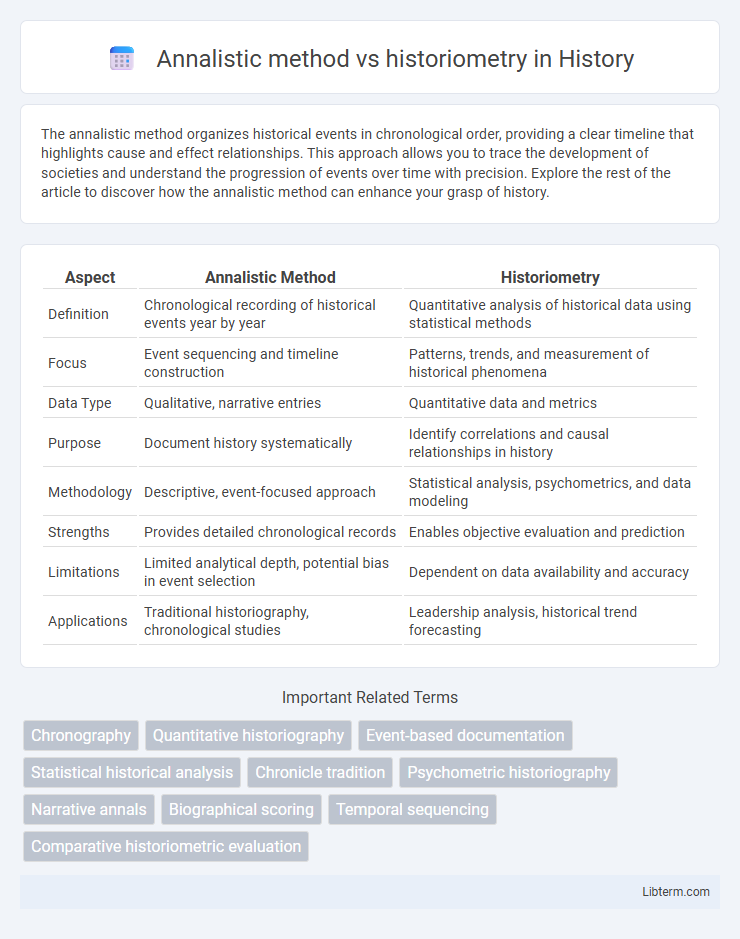The annalistic method organizes historical events in chronological order, providing a clear timeline that highlights cause and effect relationships. This approach allows you to trace the development of societies and understand the progression of events over time with precision. Explore the rest of the article to discover how the annalistic method can enhance your grasp of history.
Table of Comparison
| Aspect | Annalistic Method | Historiometry |
|---|---|---|
| Definition | Chronological recording of historical events year by year | Quantitative analysis of historical data using statistical methods |
| Focus | Event sequencing and timeline construction | Patterns, trends, and measurement of historical phenomena |
| Data Type | Qualitative, narrative entries | Quantitative data and metrics |
| Purpose | Document history systematically | Identify correlations and causal relationships in history |
| Methodology | Descriptive, event-focused approach | Statistical analysis, psychometrics, and data modeling |
| Strengths | Provides detailed chronological records | Enables objective evaluation and prediction |
| Limitations | Limited analytical depth, potential bias in event selection | Dependent on data availability and accuracy |
| Applications | Traditional historiography, chronological studies | Leadership analysis, historical trend forecasting |
Introduction to Annalistic Method and Historiometry
The Annalistic Method systematically records historical events in chronological order, emphasizing precise timelines and factual accuracy to analyze social and cultural patterns over time. Historiometry combines quantitative analysis with historical data to statistically evaluate the impact of individuals and events, often focusing on psychological and biographical factors. Both methods leverage structured data but differ in approach: Annalistic Method focuses on event sequencing, while Historiometry emphasizes measurement and comparison of historical influence.
Defining the Annalistic Method
The Annalistic Method involves recording historical events in a chronological, year-by-year sequence, emphasizing precise dating and factual accuracy. This approach prioritizes the systematic collection of annual records, often relying on official documents and contemporaneous accounts to construct a linear timeline. In contrast, historiometry applies quantitative analysis and statistical techniques to study historical data, focusing on measuring traits, patterns, or impact within historical figures or events rather than just chronological narration.
Understanding Historiometry
Historiometry applies quantitative analysis to historical data, measuring psychological traits and patterns in influential figures through statistical methods, unlike the Annalistic method that relies on chronological recordings of events. Understanding historiometry involves examining metrics such as creativity scores, leadership effectiveness, and cognitive abilities, derived from biographical sources and archival records. This approach enables objective comparisons and insights into historical personalities by leveraging statistical tools to evaluate behavioral and cognitive dimensions.
Historical Backgrounds of Both Methods
The annalistic method, rooted in ancient chronicle traditions, emphasizes recording historical events in a sequential, year-by-year format, originating from Mesopotamian and Roman historical practices. Historiometry, emerging in the 20th century through the work of philosophers like Francis Galton, integrates quantitative analysis and psychometric techniques to study historical figures and patterns. Both methodologies reflect evolving approaches to historiography: annalistic emphasizing chronological narrative structure, while historiometry focuses on empirical measurement and statistical evaluation of historical data.
Core Principles and Procedures
Annalistic method emphasizes chronological recording of events, focusing on detailed annual accounts to establish a sequential historical narrative. Historiometry applies quantitative analysis to historical data, using statistical techniques to investigate patterns and measure individual or collective psychological traits over time. Core procedures in annalistic research involve meticulous data compilation from primary sources, while historiometry requires data coding and computational modeling to draw empirical conclusions about historical phenomena.
Strengths and Weaknesses of the Annalistic Method
The Annalistic method excels in providing a straightforward, chronological account of historical events, ensuring clarity and ease of understanding for timeline reconstruction. Its strength lies in the systematic preservation of year-by-year records, allowing researchers to trace developments and context within a specific period. However, the method's weakness is its tendency toward oversimplification, often neglecting deeper causal analysis or thematic connections that historiometry might reveal through statistical and psychological measurement techniques.
Strengths and Weaknesses of Historiometry
Historiometry excels in quantifying historical data through statistical methods, enabling objective analysis of patterns such as leadership traits and genius correlations across time. Its main strength lies in synthesizing vast amounts of biographical and historical information to identify measurable trends, but it faces weaknesses in potential biases due to selective historical records and difficulties in standardizing subjective data. Unlike the Annalistic method, which offers a straightforward chronological account, historiometry requires careful methodological rigor to avoid overgeneralization and ensures validity in interpreting historical figures' quantitative data.
Applications in Modern Historical Research
Annalistic method emphasizes chronological recording of events, providing a structured framework for analyzing timelines in modern historical research. Historiometry applies statistical techniques to historical data, enabling quantitative assessment of historical figures' traits and societal trends. Combining both approaches enhances accuracy in reconstructing historical narratives and understanding historical phenomena through both qualitative and quantitative lenses.
Comparative Analysis: Annalistic Method vs Historiometry
The Annalistic Method relies on chronological recording of historical events, emphasizing sequential accuracy and temporal context, while Historiometry employs quantitative analysis and statistical techniques to evaluate historical figures and patterns. Comparative analysis reveals that the Annalistic Method excels in documenting factual timelines but lacks predictive power, whereas Historiometry provides measurable insights into historical trends and character traits through data-driven assessments. Integrating both approaches enhances comprehensive historical understanding by combining detailed event chronology with empirical evaluation of historical significance.
Future Directions and Methodological Integration
Future directions in historiometry emphasize leveraging big data analytics and machine learning to enhance predictive capabilities, while the annalistic method benefits from digitized archives enabling chronological data mining. Methodological integration involves combining the annalistic focus on sequential event documentation with historiometry's quantitative statistical analysis, creating a hybrid approach for interpreting historical trends with greater accuracy. This synthesis supports more robust forecasting models and enriches historiographical research through interdisciplinary collaboration.
Annalistic method Infographic

 libterm.com
libterm.com